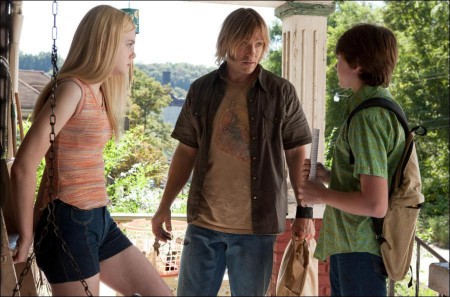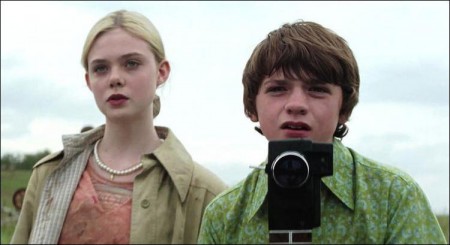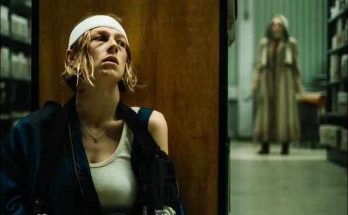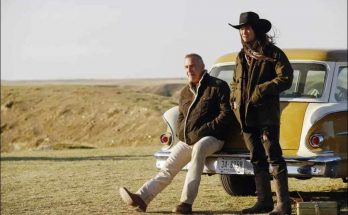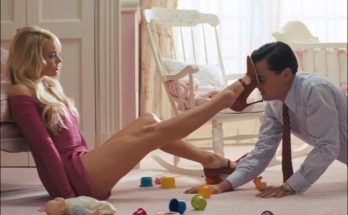Inside the story of Super 8 is another story: J.J. Abrams decided early on not to write a formal script for the movie that the kids are shooting within the film but, instead, to let it emerge organically, inthe- moment, from the cast’s imagination.
The filmmakers were impressed. “They all had an amazing knack for picking up filmmaking really quickly,” observes Bryan Burk.
Adds Burk: “What I hope and get excited about with ‘Super 8’ is that kids seeing this film might be inspired to go out and make their own movies. There’s something magical about that time when all that was required to make a movie was convincing your friends to spend their summer devoted to the project. I think J.J. will give people that bug, when they realize all you need is a camera, a group of friends and an idea to make great things happen.”
Abrams observes that aspiring moviemakers growing up today have a wealth of digital technology at their fingertips that his generation could only dream about. “The technology has been so democratized that, whereas in 1979 it was a real exception for a kid to have a camera, today they are ubiquitous,” he says. “Every phone has a video camera. The ability to make a home movie that looks the way you can today is something that never existed when I was a kid, but I wish it had.” The 70s World of “Super 8”
If the cast and filmmakers are the heart and soul of “Super 8”, the equally vital skeleton of the film is its visual design. It brings to life a kids’ eye-view of a typical late 70s, working-class, Midwest town and then catapults it into fantastical events, which turn the carefully crafted reality of the place inside out.
“J.J. very much wanted the feel of the movie to be 1979 but, at the same time, he wanted to give audiences the kind of visuals that only today’s special effects make possible,” notes executive producer Guy Riedel. “There’s that sweetness and lightness evoked by 70s movies, but there’s also no doubt that it is very much a 21st Century J.J. Abrams movie.”
The merging of styles began with the work of director of photography Larry Fong (“300,” “Watchmen”), who Abrams first started working with back in the Super 8 days and has continued to collaborate with on several television series, including “Lost.” Fong is not only one of Hollywood’s top action cinematographers, but also a highly accomplished magician and Abrams wanted him to bring that same sense of the out-of-the-ordinary and sudden surprise to the imagery of “Super 8.”
Says Abrams: “Larry was a kid making movies across the street when first I met him. We became friends and have remained friends since. It was so much fun working with him on this movie because it reminded us so much of what we loved to do as kids.”
Fong’s visuals, which can move from the intimate to the eye-popping, impressed the filmmakers, but it was his prestidigitation that captivated the young cast. “Larry Fong is a mind-blowing magician,” states Joel Courtney. “Every once in a while he would show us how to do a cool trick, but the best part was not knowing how he did them.”
Adds Ryan Lee: “Larry really understood that we needed to have fun to keep us from getting too stressed out on the set. His tricks constantly kept us guessing.”
Meanwhile, the trick of bringing to life the prototypical American mill town of Lillian, Ohio fell to production designer Martin Whist, who previously collaborated with J.J. Abrams on “Cloverfield.” Whist always expects a fun read when Abrams is involved, but the script for “Super 8” took him aback. “It read like an immediate classic,” says the designer. “It had all the elements of movies I loved growing up, but it also felt as though it was the next generation of that kind of story telling.”
He knew from that first reading that he wanted to create a very well-defined, detailed world for these characters and then shake it all up. “My first conversations with J.J. revolved around the fact that we wanted to make everything about the town feel textural, tangible and believable for the era,” Whist recalls. “We had to establish a strong sense of everyday reality, so that when the fantasy elements come into it, the surreal becomes a haunting layer over something that feels very familiar.”
Whist and Abrams both wanted to be as true to the vibrant styles of the late 70s as they could. “We wanted it to be subtle, but the era is an ever present visual influence in the film, especially in the strong colors.” Whist explains. “They stand out because we don’t really use a lot of those colors anymore like olive, burnt orange and ochre. I think I used more shades of brown in this movie than I ever have in my life before!”
Whist continues: “J.J. helped us a lot with the research. He has a great collection of Super 8 magazines from the past, which contained a lot of ads. Looking at all that stuff really cued our own memories and then we would just start brainstorming as to what to create for each character. To me, the secret to creating the authenticity of an era is to be understated. It’s the cumulative effect of small, visceral moments that make you feel you’re in another time, and that’s what we aimed for.”
Costume designer Ha Nguyen (“Shooter,” “Mask”) also found much of her research material in magazines and catalogs; especially in circa 1970s clothing catalogues, which revealed what regular Midwesterners were sporting in that in era.
“I looked at some real school yearbooks from the late 70s,” comments Nguyen. “One was from Ohio, another from Texas and one from Indiana. I compared them to the clothing catalogues I had and it was also pretty much the mid-western clothing that was selling, so it all fit together. We didn’t want the wild 70s styles you might see in fashion layouts. We wanted people to look real.”
With such a large number of military costumes needed for the latter half of the film, Nguyen brought in a Military Costumer, N. Edward Fincher, to work with her. “Ed took care of all the uniforms for us to make sure it was all done very authentically,” she says.
For the main characters, Nguyen set out to highlight six very distinct, young personalities. “Each kid has his or her own completely unique look, with different patterns and colors. Some are a little quirkier, like Charles, and some are a bolder and brighter, like Cary,” Nguyen explains. “We especially had a lot of fun with Joe’s clothing which changes as he goes from being more soft-spoken to really gaining confidence. The colors he wears get stronger and stronger, building towards the climax.”
Dressing Elle Fanning as Alice was another intriguing challenge. “The description of Alice in the script was that, even though she is still a kid, she is also very beautiful,” says Nguyen. “That’s not hard to get across with Elle because she, herself, is absolutely stunning. J.J. also wanted her to be a bit tomboyish. I found softer fabrics for her t-shirts to give her a little more shape, but still kept her tomboy look by using a slightly rougher fabric for the outerwear.”
Fanning sums up the cast’s reaction to the costumes: “They totally transported us back in time. I was mesmerized by them. I’ve always loved vintage clothing. It’s just fun to wear totally different clothes because it allows you to be a totally different person.”
Beyond the look of “Super 8” is another key layer: Michael Giacchino’s score, which challenged him to meld the fun-loving sounds of the 70s with the roller-coaster emotions of a dramatic thriller. An Oscar® winner for “Up” (Original Score), Giacchino has collaborated with Abrams on all of his films.
“Like the rest of us, Michael made Super 8 movies as a kid and he told us ‘I have to score this movie,’” recalls Burk. “He approached it completely from the character’s point of view and he and J.J. spent a lot of time talking about everything that was happening emotionally in the script. Music is always at the center of J.J.’s films, and Michael is always right there with him.”
Related Link: Read the Full Production Notes for Super 8
Visits: 119
